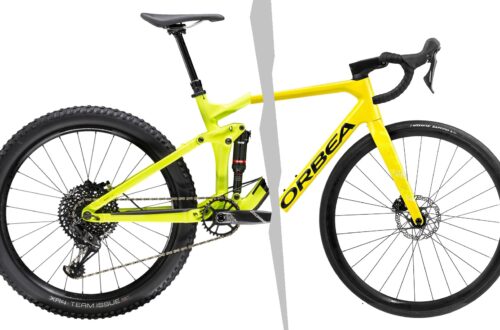
Are Electric Mountain Bikes The Future?
Since electric mountain bikes have entered the world of mountain biking, they’ have’ve become quite popular. With hearing a lot about them and seeing them around you, you may start to think that eMTBs are the future and that they will replace regular mountain bikes.
An electric mountain bike will never fully replace a regular mountain bike. Both mountain bikes have a different purpose and thus both have their own place in this world. The factors that determine which bike suits you best, are: where you ride, what your budget is and what you want to get out of your ride.
With the rise of the electric mountain bike, is a regular mountain bike a dying breed? Should you get rid of yours right now? I’ve looked at the purpose of each bike type and I’ll explain if there is a place for both.
The Evolution Of The Electric Bike
Electric bikes have been around longer than most people think. By the end of the 19th century, inventors already designed and built concepts of an electric bike. However, those ‘bicycles’ had little resemblance with the principle of an electric bike as we know them today; they were usually throttle control, not pedal-assist. It was not until 1989 that something revolutionary happened: Michael Kutter invented the first electric bike with pedal-assist as we know it today.

The Evolution Of The Electric Mountain Bike
People have been using bikes as a way of transport since the beginning of the 19th century. But the concept ‘mountain bike’ is relatively new. The first production mountain bike dates back to 1981 and was the Specialized Stumpjumper. From this point, it took almost 30 years before the first electric production mountain bike was born: the Haibike eQ Xduro. Since the first order sold out quickly, it was a great success. But it still took a few years before other manufacturers started to believe in this concept. In 2018 a lot of well known but also new brands launched their first e-mtbs.

What’s The Purpose Of An Electric Mountain Bike?
The thought behind an electric bicycle, is to help you go farther and faster whilst still getting a workout. It is a great way to replace car trips as long as you don’t need to carry a lot of things. It’s better for your wallet, better for your health and it is also seen as better for the environment. A lot of people who barely rode a bike in the past, now find cycling much more appealing.
Since an electric mountain bike gets used for very different reasons than an electric city bike, we’ll now dive into the thought behind the e-mtb.
The Fun-Factor
But since mountain biking is seen as a sport, then why add an electric motor? Most people ride them especially for the cardio workout, so the motor would ruin the whole point of getting on that bike, right? Since Haibike introduced their first e-mtb, a lot of consumers and other manufacturers thought the same way. They thought it would never catch on. But what Haibike already knew, was that e-mtbs are a lot of fun and they can be an addition to the sport without removing the workout-factor.
Working Out
A misconception a lot of people have, is that riding an electric mountain bike would no longer be as physical demanding as riding a regular mountain bike. Research has shown that this is not actually the case. Of course, there are exceptions in which a lazy mountain biker uses the pedal-assist to send him uphill and become even more lazy. But in general, this is not the case. By switching the pedal-assist off or by putting it in the lowest mode of assist, you get whole new sort of workout. You now not only have to battle that hill, but you also have to work with the weight of your bike and the drag of the motor.
But in general, as soon as you get on an electric mountain bike, you start riding differently. An e-mtb is incredibly capable and you are now able to tackle the more technical stuff. Best of all: it doubles downhill time and halves the uphill time. All of this creates a trigger for you to cycle more often and farther and therefore doesn’t make you more lazy.
Physical Limitations
But there is a side note to add to this story. Since the intention is not to make your workout lighter but more fun, you still have the ability to do so if you need to. Via the control panel on your handlebar, you can make a ride as tough as you fancy. Which can be very appealing for another target audience: people with physical limitations.
If you have a heart condition or you are recovering from an injury, riding a regular mountain bike can be very challenging and off putting. On an electric mountain bike, someone with a limitation can now exercise like anyone else and more importantly, with anyone else. It is a great way to join a group without having the feeling that you can’t keep up. Everyone can have a great time in their own way.
The same goes for the older mountain bikers among us. They might not be as fast as they used to be (but still want to be) or are new to this sport and regret that they didn’t start earlier. Especially when electric mountain bike just entered the market, there were a lot of older riders that bought them. Without these bikes, they might’ve given this beautiful sport up.
Are Electric Mountain Bikes The Future?
In the previous paragraphs, we talked about why an electric mountain bike exists. There are some really good reasons why an electric mountain bike should suit a lot of people, but does that actually mean that it will eventually replace a regular mountain bike? Is that extra dimension that a motor creates, something every mountain biker is looking for?
A regular mountain bike as we know it since 1981, is a fantastic machine for exploring new trails. Although the basic principle remained the same over the years, but through the years they have become longer, lower and slacker. They received a new geometry, different materials were used and new categories were added. Lets look at some arguments why a regular mountain bike should not cease to exist.
Budget
The price of a regular mountain bike is the reason why it is more suitable for a wider audience. A decent electric mountain bike will set you back at least €4000 or $4250; a decent regular mountain bike will cost you around €1500 or $1600. That isn’t money that everybody has just laying around. Especially if you don’t ride frequently. A regular bike can be left sitting for years; an electric mountain bike should be charged once in a while to keep the battery in good condition.
Also the maintenance costs of a regular mountain bike are a lot lower since the stress on the components isn’t so high. If a motor or a battery of an e-mtb fails, it can set you back around €800 or $850. This definitely should be kept in mind when looking into the electric variant.
Weight
Although many people think otherwise, mountain bikes haven’t become lighter. This is due to the fact that bikes nowadays have a larger wheel size (27,5” or 29” instead of 26”), new frame geometry (more robust for dealing with impacts under higher speeds), wider tires and therefore a wider shock, bigger brakes etc. The average weight of a regular bike is between 10-13kg; the average weight of an electric mountain bike is between 20-25kg. A regular bike is still very light.
Because of its weight, a regular mountain bike is very playful and easy to control, especially on fast and steep descents. If you need to get it over a blockage on extremely rough terrain or simply get it out of your apartment building, they are very easy to lift. Transporting is piece of cake, since you can easily put it inside or on the back of your car on a bike rack. With an electric mountain bike, this isn’t as easy.
Riding Characteristics
A regular mountain bike is due to its weight and smaller turning circle, way more agile than an electric mountain bike. As explained before, an e-mtb can be used for very technical stuff as it can plow through pretty much anything if you want it to. But when things get narrow with very sharp turns, a regular mountain bike will win. If you are skilled, you can put it in basically any position you like.
When dealing with a slippery, washed out, leaf and root covered steep climb, nothing beats the feeling of conquering it on a mountain bike using nothing but your leg power. You are constantly looking for the best line to keep you upright. The threshold for starting this climb might be a little bit higher than on an e-mtb, but you will be more proud of yourself in the end.
Summary: Are Electric Mountain Bikes The Future?
With this article, the goal was to inform you about the place of a regular mountain bike in a world where electric mountain bikes are becoming more common. By looking at the thought behind the two types, it is clear that they both hold a place in this world and thus can live side by side just fine. A regular bike will not become extinct.
There are basically three factors which determine if you should go for a regular mountain bike or an electric one: where you ride, what you want to get out of your ride and what your budget is. If you’re all about agility or lightweight or if you are on a tight budget, than you should definitely go for a regular mountain bike. They will remain available in bike shops.
Frequently Asked Questions
Will A Regular Mountain Bike Become Extinct?
A regular mountain bike has a very different purpose than an electric mountain bike. Both get used differently and it depends on a few factors which one is the most suitable for you: where you ride, what your budget is and what you want to get out of your ride.
Should I Switch To An Electric Mountain Bike?
With the arrival of the electric mountain bike, there’s now a new division added tot the world of mountain biking. Go for some test rides and find out what an electric bike has to offer for you. You should only switch to the electric version when it actually suits you. A regular mountain bike will not cease to exist.
Will Electric Mountain Bike Become Cheaper?
Electric mountain bikes will become cheaper in the future. Since the first e-mtb was launched in 2010, the concept is still relatively new. The technology is evolving rapidly and with the increasing sales figures, the prices will come down.





